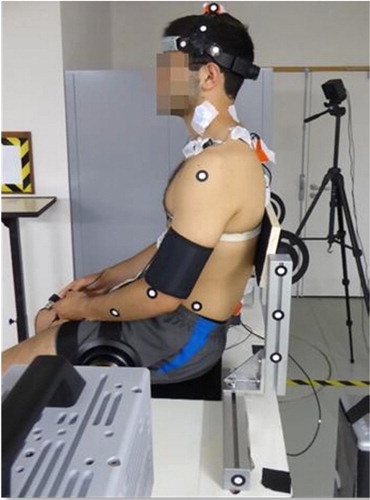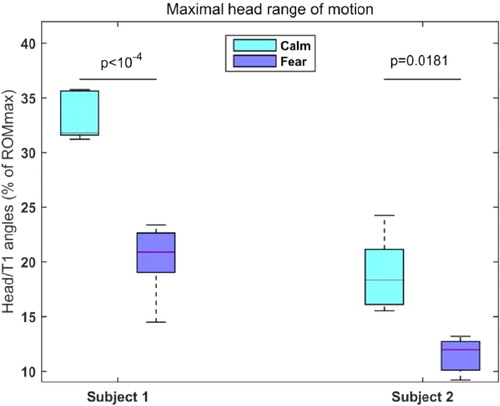1. Introduction
A variation in the human emotional state induces physiological and behavioural changes. In particular, fear environments induce increase of muscle potential (Ax Citation1953). When submitted to external accelerations, the stabilization strategies of the head might then be influenced (Vibert et al. Citation2001).
The aim of the present study is to validate an experimental protocol linking a pre-impact emotional change to head-neck movement variations.
2. Methods
Two healthy male volunteers (n°1/2, 22/24 y.o., 174/170 cm, 68/64 kg) have been seated on a 4meter-long linear sled (Sandoz et al. Citation2014) instrumented by an on-board 50 Hz lateral video camera and a 6-axis force sensor underneath the seat surface (AMTI, 200 Hz). They were secured by a thigh belt and a backrest (). Three Inertial Measurement Units (IMU, Xsens, 100 Hz) have been placed at the top of their head, T1 and S1 vertebrae, in order to measure the body segment angle variations. The physiological states have been recorded at 1,000 Hz using a pulse transducer for the heart rate a galvanic skin response (GSR) finger electrodes for the stress level, through the electrodermal activity (EDA, ADInstruments,) and a respiration belt for the breathing frequency. A blood pressure device (Omron Evolv) measured the diastolic and systolic pressures (manually triggered).
In order to create an emotional environment, 10 minutes of a calm film (‘Earth’ documentary) and a fearful film (scenes from ‘The Conjuring’ and ‘The Conjuring 2’) have been screened on a 17-inch display placed in front of the seated subject at his eyes level. Both films contain video clips that have been selected and edited according to the criteria recommended by Gross and Levenson (Citation1995) and Hasson et al. (Citation2008).
The State-Trait anxiety Inventory (STAI) assessed the emotional arousal of the subjects at the beginning of the experiment, evaluating the subject’s both current state of anxiety (Y-1) and general states of tranquillity (Y-2) (Spielberger et al. Citation1983). After being exposed to each film, the current state of anxiety has been evaluated.
The sled pulses were close-loop controlled and robustly produced a forward sinus shape acceleration during 2 s for a maximum of 0.3 g.
First, volunteers have been submitted to 3 pulses. Then, the calm film has been screened, followed by 5 pulses. Finally, the fearful film has been screened, followed by 5 pulses.
The baselines parameters have been recorded while seated on the montionless sled, before any sled pulse. The angle between head and T1 has been normalized by the natural voluntary head flexion-extension Range Of Motions (ROM) and expressed in %. The physiological states during each screened film have been compared to the baseline. Both physiological changes and head flexion-extension kinematic angles have been compared between volunteers and studied in relation with the emotional state. Inter-subject analysis has been done using a non-paired two-tailed T-test to compare the parameters’ variation between the two subjects. Intra-subject analysis has been performed using a paired two-tailed T-test to compare the parameters’ variation for each subject. P-values below 5% were considered statistically significant.
The protocol has been approved by the French Ethics Committee CPP IDF VII 15-018.
3. Results and discussion
From the calm to the fearful film, the two volunteers observed increases of EDA (min 120%), breathing frequency (min 54%), systolic blood pressure (min 7 mmHg), and a very slight decrease of the heart rate (max 3 beat/min). The Y-1 score increased with a minimum of 14 points, which is related to fear and tension feelings. These physiological responses were characteristics of a freezing response to external stress.
Regarding the head kinematics, the two volunteers’ maximal head/T1 ROM significantly decreased from the calm to the fear configurations with p < 10−4 and p = 0.0181 for subjects 1 and 2 respectively (). It appeared that the subject 1 had significantly higher (p = 0.0059) head/T1 angles compared to subject 2. The STAI questionnaires also revealed that the volunteer 1 was clinically tranquil subject, while the volunteer 2 was clinically anxious.
4. Conclusions
With only two subjects tested, present findings can obviously not be generalized to a general population. However, it is interesting to notice that we succeeded to create an emotional environment, efficient to induce fear, with measurable physiological changes. These emotional changes seemed to have a significant effect on the head stabilization strategies. Moreover, the link between general state of tranquillity and head kinematics under dynamic solicitation has to be investigated further.
Following the present study, we are currently performing similar experiments on a cohort of 15 volunteers, using virtual reality helmet and headphones in order to optimize the visual input, 3D immersion and emotional change effectiveness. A specific care is taken to avoid motion sickness and various virtual environments are proposed to target different fear and calm sensitivities.
Additional information
Funding
References
- Ax AF. 1953. The physiological differentiation between fear and anger in humans. Psychosom Med. 15(5):433–442.
- Gross JJ, Levenson RW. 1995. Emotion elicitation using films. Cogn Emotion. 9(1):87–108.
- Hasson U, Furman O, Clark D, Dudai Y, Davachi L. 2008. Enhanced intersubject correlations during movie viewing correlate with successful episodic encoding. Neuron. 57(3):452–462.
- Sandoz B, Simonin A, Saletti D, Laporte S. 2014. Sled acceleration control for low-speed impact testing and transient response studies. Comput Methods Biomech Biomed Eng. 17(Suppl 1):48–49.
- Spielberger CD, Gorssuch RL, Lushene PR, Vagg PR, Jacobs GA. 1983. Manual for the State-Trait Anxiety Inventory. Consulting Psychologists Press.
- Vibert N, MacDougall HG, De Waele C, Gilchrist DPD, Burgess AM, Sidis A, Migliaccio A, Curthoys IS, Vidal PP. 2001. Variability in the control of head movements in seated humans: a link with whiplash injuries? J Physiol. 532(3):851–868.


